Hey there, fellow entrepreneurs! Ready to conquer the online business world with multiple Shopify stores? I sense your excitement buzzing!
Shopify is a fantastic platform that empowers us to run our stores like pros. But let’s face it – even managing a single business can be a rollercoaster ride. And when you add multiple stores to the mix, it’s like that rollercoaster got a double shot of espresso!
In this blog post, I’ll spill the beans on some savvy strategies for managing multiple Shopify stores like a boss. We’ll dive deep into the details and uncover the nitty-gritty details and secrets that’ll make your life a whole lot easier. Get ready for some serious store management magic!
But first, let me introduce you to three fascinating store owners. Picture this: Terry, Rachel, and John. Each of them has multiple Shopify stores, but they’ve all got their own unique way of tackling the management challenge.
Let’s meet them, shall we?
Imagine Terry, the diligent entrepreneur. He spends his days logging in and out of each Shopify store. It’s like a never-ending game of “click here, click there,” and boy, does it eat up a ton of his precious time. Poor Terry, he’s practically got a full-time job just managing logins!
Then we have Rachel, the clever one. She’s also rocking multiple Shopify stores, but she’s found a clever workaround. Rachel links all her stores to a single email ID within Shopify. It’s a step in the right direction, no doubt. But here’s the catch – Rachel still has to remember a gazillion passwords for each individual store. Talk about a memory workout!
And finally, meet John, the risk-taker. He’s taken a page from Rachel’s book and consolidated all his stores under one admin email on Shopify. But wait, there’s more! John kicks it up a notch by using the exact same password for every single store. Sure, it saves him a few brain cells, but it’s like leaving the front door wide open for hackers. Yikes!
Now, here’s the million-dollar question: Who’s the smartest store owner in the bunch? Terry, Rachel, or John?
Drumroll, please… And the answer is… None of them!
Yep, you heard that right. Despite their valiant efforts, all three of our store owners are making rookie mistakes that can drive anyone bonkers:
- Terry wastes time with endless logins.
- Rachel struggles with password overload.
- John risks security with a one-size-fits-all password. Not a good idea, my friend!
If you relate to Terry, Rachel, or John, fear not! We’ve got a game-changing solution to manage all your stores from a single, stress-free hub. But before we the secret sauce, let’s explore the undeniable advantages of having multiple Shopify shops.
Ready to discover the perks of this multi-store adventure? Let’s dive right in!
Why having multiple Shopify stores is the right choice?
Having more than one Shopify store can be super helpful for your online business! Let’s explore three situations where having multiple stores on Shopify can be a smart choice:
- Selling to people around the world: If you want to sell your products to people in different countries, it’s important to understand their different needs and preferences. Creating separate stores for each country, with things like language, currency, and pictures that match their culture, can make people feel more connected to your products.
- Reaching out to different customer segments: If you sell different types of products, you might want to create separate stores for each type of customer. This way, you can speak their language, show pictures of happy customers who are just like them, and use colors and words that they love.
- Having a special discount store: Sometimes, you might want to sell some products at really low prices to get rid of them quickly. Instead of doing this in your main store, you can create a separate store just for these special discounts. That way, you won’t make your regular customers think your products are not valuable anymore.
Now that we know why having multiple Shopify stores under one account is a good idea, let’s answer some frequently asked questions about managing them.
What are the challenges of managing multiple Shopify stores?

While having more than one Shopify store can be exciting, it also comes with a good number of hurdles. Here are some challenges you might face:
- Dealing with orders: When you have many stores, it can be hard to keep track of orders. Fulfilling and handling returns from each store can get confusing.
- Managing inventory: If you sell the same things in different stores, it’s important to update how many items you have. You need to make sure you have enough stock when people buy and adjust it when they return things.
- Organizing product information: Having different stores means you might structure product details differently. This can make it hard to keep things organized and consistent.
- Making everything work together: Connecting your stores with other systems like ERPs (Enterprise Resource Planning) or POS (Point of Sale) can be a bit complicated. It takes some extra effort to make sure everything works smoothly.
Remember, even though these challenges exist, there are ways to overcome them and make managing multiple Shopify stores a breeze!
How to manage multiple Shopify stores the right way?
Managing several Shopify stores may seem tough, but with the right approach, it’s totally possible! Here’s what you need to know:
- Keep track of your products
Use a management system that updates your inventory in real-time. This helps you avoid selling more products than you actually have. Moreover, it keeps your customers happy with a smoother shopping experience. - Optimize each store individually
If you have different stores for different markets or different types of customers, make sure each one is unique and relevant. Use local keywords and country-specific offers. Also, create content and designs that make sense for each group of customers. - Centralize order management
It’s important to have a centralized system that helps you keep track of all the orders from your different stores. This way, you can easily send products to customers, track orders, and handle any returns. - Use a product information management (PIM) system
When you have many stores, it can be hard to keep all the product details in order. That’s where a PIM system comes in handy. It helps you keep everything neat, accurate, consistent, and up to date. - Create a unified customer support system
Keep all customer queries and order information in one place. This makes it easier for your customer support team to help everyone quickly and make sure you have the highest level of customer satisfaction and retention.
By implementing these strategies, you’ll be able to set up and manage your multiple Shopify stores like a pro! It’s all about keeping things organized and making sure your customers have the best experience possible.
Best Shopify apps for managing multiple Shopify stores
When it comes to efficiently managing multiple stores, the right Shopify apps can make all the difference. Here are some top choices:
Veeqo
Keep your inventory in check across multiple stores with Veeqo. This powerful app syncs inventory in real-time across various Shopify stores, eCommerce marketplaces, and warehouses, ensuring you never oversell or undersell your products.
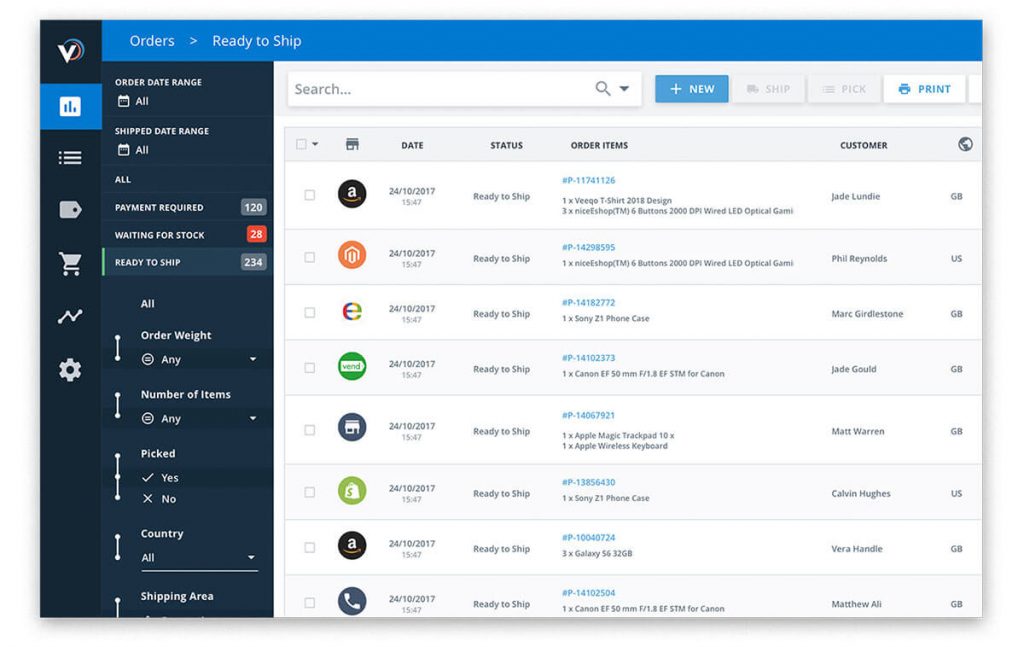
Features
- Warehouse inventory transfer
- Automated purchasing management
- Cycle stocktake with the Veeqo Scanner
- Perfect stock taking
- Inventory automation rules
- Product bundles
- Detailed performance reports
- Warehouse management
- Accounting streamline
- Purchase order management
- Cloud-based operation
- Physical store connectivity
Price: $120/month
Shipmonk
Streamline your order processing, production, and shipping with Shipmonk | Order Fulfillment. This app enables you to proactively manage and track your orders for efficient delivery and fulfillment.
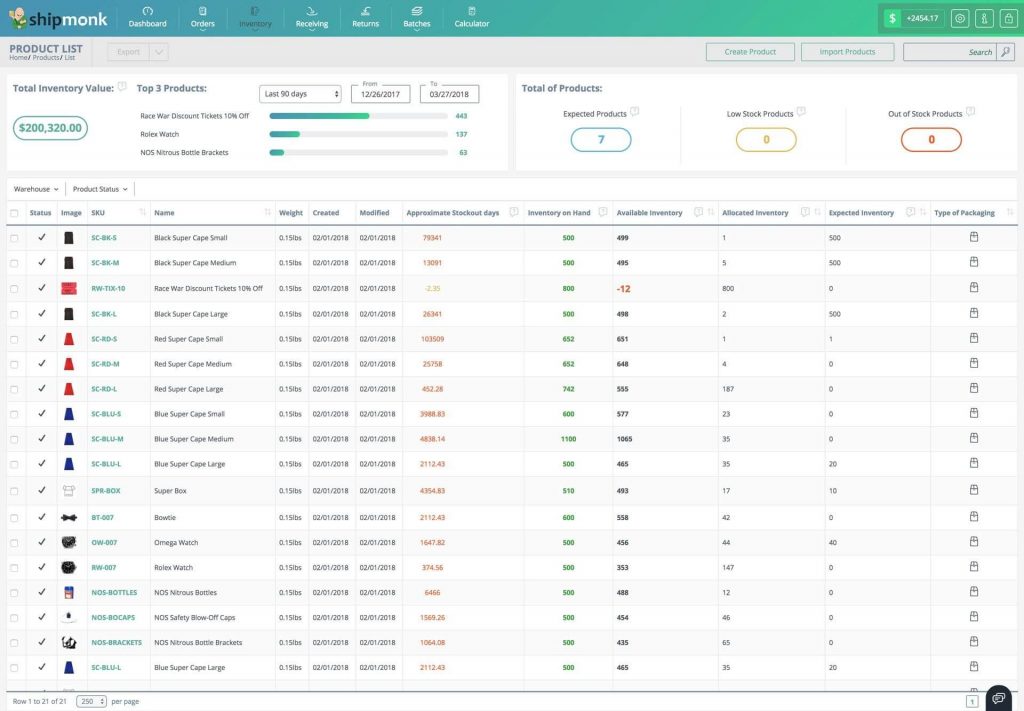
Features
- Inventory management
- Returns
- Snap ‘n Pack
- Order tracking
- Multiple warehouses
- Billing breakdown
- Data importing
- SKU photos
- Automatic reship
- Get rid of manual CSV export
- Get error checking and report
- Support customers via chat, email and phone
- Rewind backs up millions of items
- Comply with GDPR legislation
- Centralized management of multiple stores
- Real-time reporting
- Advanced analytics with MRR, CLTV, ARPPU, 200+ other vital metrics
- Customer insights
- RFM segmentation
- Payment analytics
- Subscription management
- Goal tracking and forecasting
- Sign in to Putler and click on the Shopify icon.
- Give your shop a name and enter your shop’s URL.
- Log in to your Shopify account.
- You’ll see a permission page – click on “grant permission.”
- Congratulations! Your Shopify account is now successfully connected to Putler.
Price: Contact custom quote.
Rewind
Safeguard your online store with Rewind backup. This app offers exceptional features to improve the security and efficiency of your e-commerce store, including automated backups and GDPR compliance.
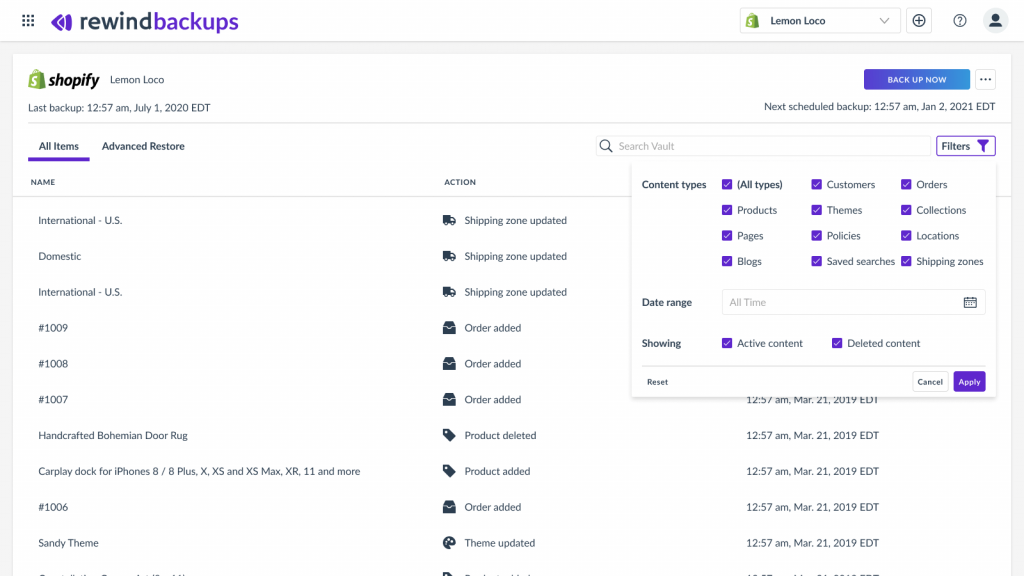
Features
Price: Free plan available. 7-day free trial. Additional charges may apply.
Putler
The ultimate tool for managing multiple Shopify stores from a single place, Putler simplifies monitoring, management, and growth of your stores. With Putler, you can connect unlimited Shopify stores to a single account, ensuring seamless control without the hassle of multiple logins.
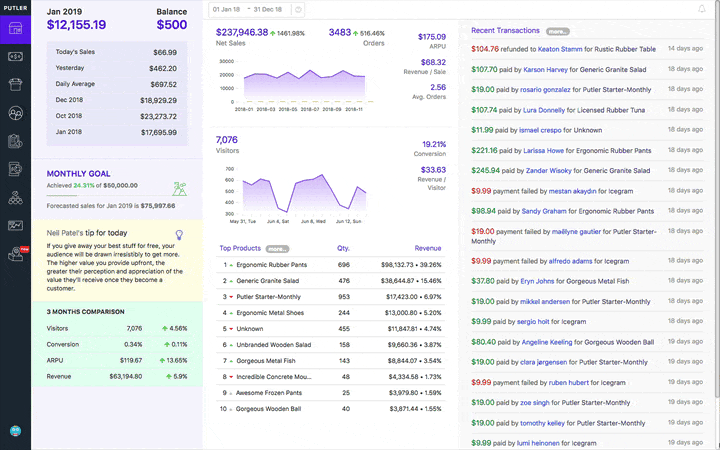
Features:
Keep reading about how Putler makes managing multiple stores on Shopify a breeze!
How to connect all your Shopify shops to Putler?
Putler lets you connect and manage multiple Shopify stores from one account Once connected Putler automatically pulls in the data and shows you reports and insights on your data.
Connecting your Shopify shops to Putler is a breeze. Just follow these simple steps:
To connect additional Shopify shops, go to Settings > Link new data source and follow the same steps.
Supervise stores as a whole or individually
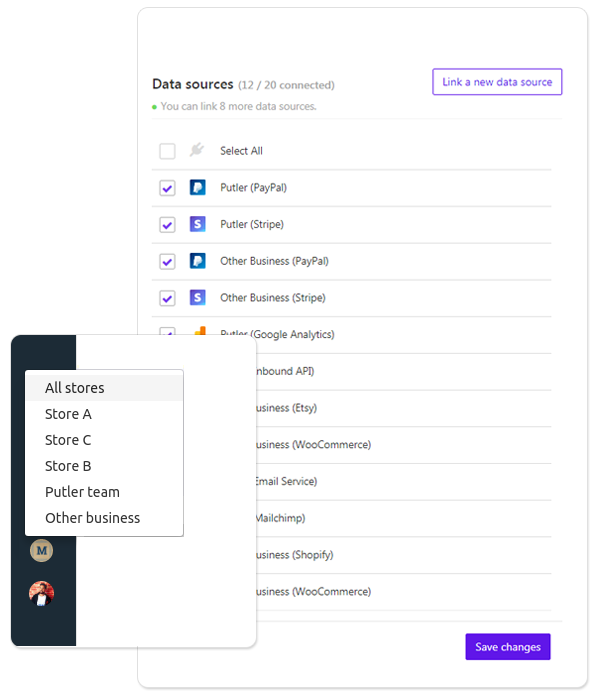
Once you connect all your Shopify stores with Putler, you have two options:
- View combined reports of all the stores
- Toggle and view reports of each store individually.
While you connect all your Shopify shops to Putler, Putler will automatically pull in data from all stores, aggregate and consolidate it and show you combined reports.
Whereas, if you want to see individual reports, you will have to create teams and assign team members to them. Here’s how.
View reports, metrics, and data within seconds
Putler is an amazing reporting tool that consolidates data from all your Shopify shops. It provides complete reports with accurate data.
Here are some of the dashboards and key performance indicators (KPIs) Putler offers:
Weekly emails
As store owners we track how our business is progressing. We probably spend a few hours each week collating data from all our multiple Shopify shops, exporting CSV’s, carrying out Excel operations, etc.
Putler saves all those extra hours for you. Once you connect all your multiple Shopify stores to Putler it syncs all your store data at runtime, giving you up-to-date reports.
Additionally, Putler also sends you/ your team a weekly email with all your important stats.
Team sharing
Just like weekly emails help you stay on top of your data, your team needs to stay on top of data too. So Putler makes this possible with its team-sharing feature.
You can invite team members and give them access to specific stores. You can choose between Admin and Support roles to control their access to data.
Toggle between multiple Shopify stores
I understand viewing combined data is magical but at times, you might want to analyze Shopify multiple stores individually, right?
Putler helps you with that as well.
You can easily create individual views of your Shopify stores and then toggle to see reports pertaining to a single Shopify store.
Over to you
Managing lots of Shopify stores can be tough, but don’t worry! With the right tools and tricks, you can make it easier and more rewarding. One tool we recommend is Putler.
Putler is like a magic wand for managing all your stores in one place. It makes things simple and saves you time and stress.
With its special features and easy-to-use design, Putler will make running your stores a piece of cake.
Don’t just take our word for it – give Putler a try and see the magic for yourself. You’ll love how it helps you manage your stores like a pro. So get ready to conquer the Shopify world with Putler by your side!
Remember, with Putler, managing multiple Shopify stores is as easy as ABC. Simplify, succeed, and watch your stores thrive!
FAQs on running multiple Shopify stores
Can you have multiple Shopify stores?
Yes, you can have multiple Shopify stores by creating different Shopify accounts for each store.
Why build multiple Shopify stores?
There are tons of reasons why you should consider building multiple Shopify stores. Some of them are if you are selling in different countries if you wish to create a separate brand if you want to create an outlet and if you want to target a particular customer segment.
Can you make multiple Shopify stores on one account?
The average Shopify store owner purchases one of 3 accounts on the platform: Basic Shopify, Shopify, or Advanced Shopify. Unfortunately, none of these plans permit you to open multiple Shopify stores under one account.
The only way to have more than one store on one account is to opt for Shopify Plus. Shopify Plus is reserved for large businesses with exceedingly high traffic, which the vast majority of store owners do not have.
If you are indeed a large business with $2,000 per month to spend on your eCommerce solution, then Shopify Plus offers an unlimited amount of stores. You get 10 included in your plan but have to pay $250 per month for each additional store.
Can I have multiple domains on Shopify?
Shopify allows for one primary domain only. However, you can have unlimited domains associated with your account.
How can I open multiple Shopify stores?
As we mentioned before, the only way to open multiple Shopify stores is by creating an account for each one.
Though you can register all of these stores under one email address, you’ll be running all of them separately on separate Shopify accounts.
However, there are apps available in the Shopify App Store that help with the management of multi stores.
For instance, if you want to run 3 different stores, you can really make your life easier by using an app to migrate data from your current store, centralize your operations, monitor all data or establish customer support.
How much does it cost to open multiple Shopify stores?
The short answer to that is a hefty sum.
Here are some of the costs you’ll incur for each of your stores:
- Shopify plan – Monthly payment between $29 and $299, plus credit card fees between 2.4% and 2.9% + 30¢ per transaction, depending on your plan.
- Theme template – One-off payment between $0 and $180.
- Shopify apps – Monthly payment is around $120 (based on Shopify News’ average app price and the average number of apps per store owner).
Multiply those costs by the number of stores you wish to open.
- Shopify advanced reporting tool
- Optimize & manage multiple Shopify stores from one place
- Tips to optimize Shopify store
- How to manage multiple Shopify stores without sacrificing conversions


Article writing can’t be easy for everyone, but you make it look like a piece of cake. I appreciate that you worked hard to make this information interesting and clear.
Thank you for your kind words 🙂